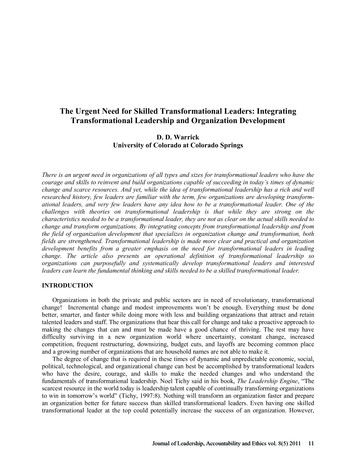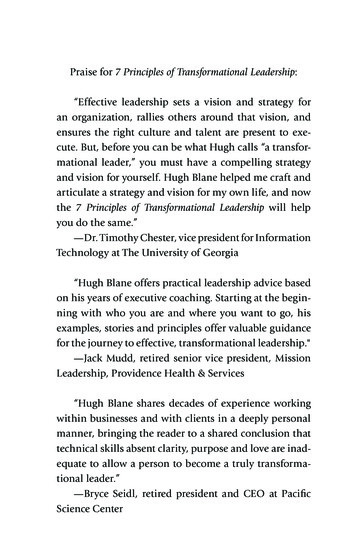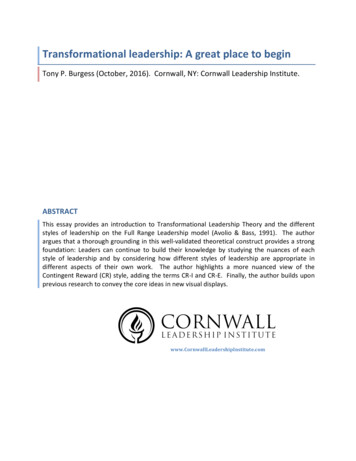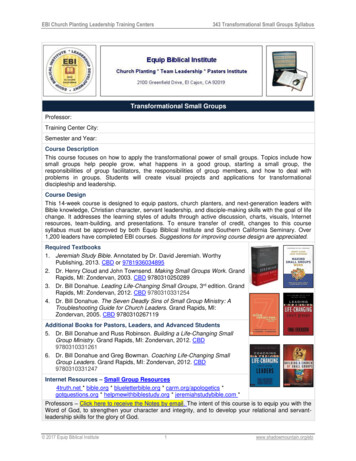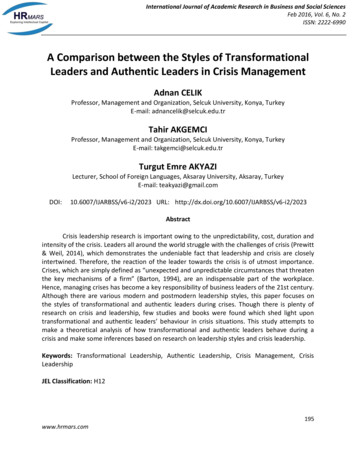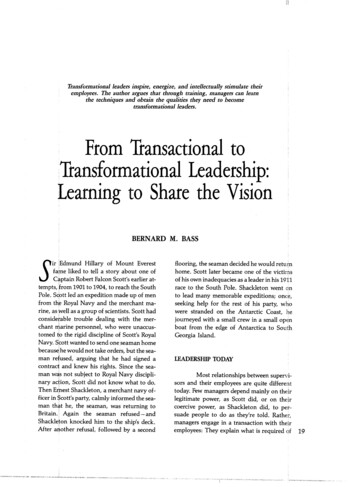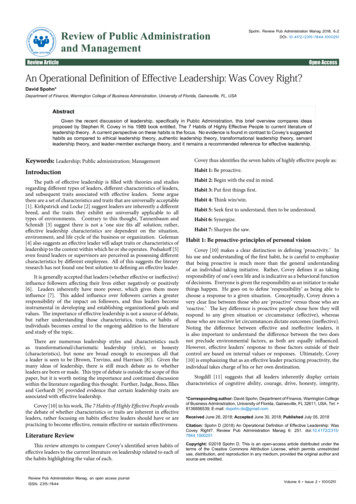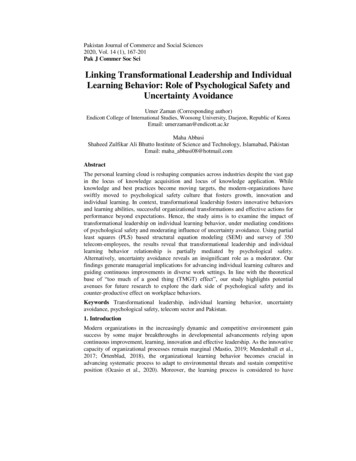
Transcription
Pakistan Journal of Commerce and Social Sciences2020, Vol. 14 (1), 167-201Pak J Commer Soc SciLinking Transformational Leadership and IndividualLearning Behavior: Role of Psychological Safety andUncertainty AvoidanceUmer Zaman (Corresponding author)Endicott College of International Studies, Woosong University, Daejeon, Republic of KoreaEmail: umerzaman@endicott.ac.krMaha AbbasiShaheed Zulfikar Ali Bhutto Institute of Science and Technology, Islamabad, PakistanEmail: maha abbasi08@hotmail.comAbstractThe personal learning cloud is reshaping companies across industries despite the vast gapin the locus of knowledge acquisition and locus of knowledge application. Whileknowledge and best practices become moving targets, the modern-organizations haveswiftly moved to psychological safety culture that fosters growth, innovation andindividual learning. In context, transformational leadership fosters innovative behaviorsand learning abilities, successful organizational transformations and effective actions forperformance beyond expectations. Hence, the study aims is to examine the impact oftransformational leadership on individual learning behavior, under mediating conditionsof psychological safety and moderating influence of uncertainty avoidance. Using partialleast squares (PLS) based structural equation modeling (SEM) and survey of 350telecom-employees, the results reveal that transformational leadership and individuallearning behavior relationship is partially mediated by psychological safety.Alternatively, uncertainty avoidance reveals an insignificant role as a moderator. Ourfindings generate managerial implications for advancing individual learning cultures andguiding continuous improvements in diverse work settings. In line with the theoreticalbase of “too much of a good thing (TMGT) effect”, our study highlights potentialavenues for future research to explore the dark side of psychological safety and itscounter-productive effect on workplace behaviors.Keywords Transformational leadership, individual learning behavior, uncertaintyavoidance, psychological safety, telecom sector and Pakistan.1. IntroductionModern organizations in the increasingly dynamic and competitive environment gainsuccess by some major breakthroughs in developmental advancements relying uponcontinuous improvement, learning, innovation and effective leadership. As the innovativecapacity of organizational processes remain marginal (Mastio, 2019; Mendenhall et al.,2017; Örtenblad, 2018), the organizational learning behavior becomes crucial inadvancing systematic process to adapt to environmental threats and sustain competitiveposition (Ocasio et al., 2020). Moreover, the learning process is considered to have
Transformational Leadership and Individual Learning Behaviorfruitful effect on organizational performance despite its challenging and tough nature(Mastio, 2019; Ocasio et al., 2020). However, in order to stay abreast of changing markettrends and technological revolution, learning behavior is vital for organizations (Ocasio etal., 2020). The worldwide telecommunication industry has stayed remarkable throughoutthe most recent decade, basically as a result of technical and industrial advancements andemerging demand of android phones.Similarly, the telecommunication industry of Pakistan has also developed due to easingtrade and investment, vigorous competition and friendly policies. The economy ofPakistan has grossed monetary, economic and societal reimbursements from thetelecommunication sector during the last decade. As of December 2019, the telecomsector in Pakistan has achieved a customer base of subscribers for cellular services (165million), 3G/4G services (76 million), basic telephony (3 million) and broadband services(78 million) respectively. As the Pakistani telecom industry has transitioned from a stateowned regulated monopoly to a much deregulated and competitive telecom structure, ithad recently attracted US 288 Million of foreign direct investments (PTA, 2019).Despite showing significant growth figures, the telecom infrastructure in Pakistan has notmaintained a fair economic growth due to the inconsistent learning behavior anduncertain avoidance culture (Afsar & Masood, 2018; Imtiaz et al., 2015; Lawrie et al.,2020).In dynamic organizational conditions, transformational leadership emerges as an effectiveleadership style for fostering change (Zaman et al., 2019b) and to stimulate learning inwhich the conventionality is challenged (Vera & Crossan, 2004). If the managers aim fortheir employees to progress and accomplish their mission, they first help them inattaining new information pertinent to the needs and integrate them within their processesand operations. Hence, the constant need for change and development has evolvedattention in the area of organizational learning (Kumar & Ganesh, 2011; Mastio, 2019;Örtenblad, 2018). In the context of Pakistan, due to the culture of dictatorship andprevalence of anxiety and stress, the tolerance towards negative behavior, conflict andresentment is high. Uncertainty avoidance is fairly related to psychological safety owingto the focus on uncertainty, tolerance, threat and challenging status quo (Frazier et al.,2017). A culture having high uncertainty avoidance often has a counter effect on workrelated outcomes and psychological safety as compared to low uncertainty avoidanceculture (Afsar & Masood, 2018; Sherf et al., 2020). A culture with high uncertaintyavoidance shows inclination towards formal rules and instructions (Hofstede, 2001).Psychological safety has also gained significant interest by scholars and practitioners(Yin et al., 2019) as it permits employee “to feel safe at work in order to grow, learn,168
Zaman & Abbasicontribute, and perform effectively in a rapidly changing world” (Edmondson & Lei,2014).Regardless of the increasing support and experimental work for investigatingpsychological safety at work (Zeng et al., 2020), the concept has still received limitedattention and some significant questions are yet to be explored for further understandingthe effect of psychological safety (Sherf et al., 2020). Hence, there is a need to fill the gapby addressing the shortcomings and extend the existing research on the construct ofpsychological safety. Therefore, current research investigates the impact oftransformational leadership and uncertainty avoidance on individual learning behaviorunder mediating conditions of psychological safety. Moreover, it is vital fortelecommunication sector to flourish the concept of psychological safety in the workplace(Zeng et al., 2020), to capture an environment and culture of continuous learning andinformation sharing, that encourages organizations to maintain core competencies andoutperform as a learning organization (Mastio, 2019; Mendenhall et al., 2017; Örtenblad,2018).2. Literature Review2.1 Transformational LeadershipTransformational leadership has been initially defined by Bass (1990). Idealizedinfluence or charisma is the first factor in the definition by Bass for explainingtransformational leadership. It means leaders act as role models for their followers andthey have high ethical standards and moral conduct. The second factor is inspirationalmotivation that describes communication of a shared vision and motivation to thefollowers for their own self-development and organizational growth. The third factor isintellectual stimulation that encourages innovation and creativity amongst followers. It isan element that initiates reasoning and vigilant problem solving with the help of thetransformational leader. The fourth factor of transformational leadership is individualizedconsideration. In this role the leaders acting as mentors, coach and advisors, they payspecial emphasis towards the follower’s personal needs (MacKenzie et al., 2001, Zamanet al., 2019b).It is argued that the transformational leadership style is distinct from other typicalleadership paradigms (Kim et al., 2019; Zaman, 2020). The transformational leadersbelong to the heroic or charismatic leadership paradigm, hence they exhibit qualities suchas ethical standards, change agents, motivators, charismatic, and compassionate (Zamanet al., 2019b; Zaman et al., 2020). The transformational leaders are recognized for their169
Transformational Leadership and Individual Learning Behaviorunique traits and tactics other than the transactional leadership style that is merely basedon exchange relationship with their followers (Zaman, 2020; Zaman et al., 2020).According to Bennis and Nanus (1985), the transformational leaders can be identified anddifferentiated on the basis of four features. First, they possess clear vision and mission.Second, for facilitating the change process they have effective communication skills.Third, they are consistent in their attitude and behaviors, hence, resulting in winning thetrust and respect from their followers. Lastly, they have a high degree of self-efficacy andself-awareness (Zaman et al., 2020).2.2 Psychological SafetySchein and Bennis (1965) pioneered the psychological safety concept and defined it as acomplex part of the unfreezing process that is essential for organizational learning andchange. The authors suggested that psychological safety diminishes fear perceptions,eliminate obstacles to change, encourages provisional ties and create tolerance towardsfailure without fear of guilt, renunciation or retaliation (Schein and Bennis, 1965). Otherstudies defined psychological safety as the feeling of showing one's self without fearingnegative consequences towards career, self-image and status (Kahn, 1990).As viewed by Edmondson (1999), psychological safety plays a central role in activatinglearning within organizations at both individual and group levels. At the group level,psychological safety is a source of providing support and healthy climate that results inimproving innovation and creativity within entire team. In the environment ofpsychosocial safety, the individuals feel safe, fearless, and they are encouraged forrecognizing their capabilities and unique skills (Cannon and Edmondson 2001).Psychological safety activates reflection, cognitive and unique thinking abilities withingroup and individuals that lead to better performance, learning behavior and outcomes(Edmondson, 1999; West 1996).2.3 Individual Learning BehaviorLearning behaviors in organizations is referred as a process of, “regularly pursuing newinformation, speaking up to assess the strength of work assumptions and allocating timein figuring out ways to advance work processes along with capturing the enduringprocess of reflection and action (Edmondson, 1999) through which knowledge isassimilated, shared and combined” (Argote, 1999; Argote et al., 2001). When themanagement of human resource started receiving scholarly attention, the first thingestablished regarding workforce development was employee behavior in an organizationand leadership response. The perspective was to make the organization a learningorganization, and for this process the two important factors are the individual approach170
Zaman & Abbasitowards learning and the other is organizational level learning (Schweder, 2020; Yadin &Or-Bach, 2019). Distinct focus is required for learning at individual level as it is thesocial factor which is affected by its surroundings and culture. This approach fosterslearning, information seeking behavior, knowledge simulation, improvement andadvancement of work processes at the individual level (Argyris & Schön, 1978; Cook &Yanow, 1993; Kolb, 2001; Senge, 2006). Along with the individual learning,organizational learning and its importance was another important factor which wasdebated during the primary phase of development. It was the idea that learning should beat organizational level, and for that organizational learning systems should be establishedand strengthened (Cook & Yanow, 1993; Schweder, 2020; Senge, 2006; Yadin & OrBach, 2019).2.4 Uncertainty AvoidanceUncertainty avoidance involves the degree of individuals’ feelings about being fearful ofcomplex, unknown and/or uncertain situations” (Afsar & Masood, 2018; Patterson &Smith, 2001; Lawrie et al., 2020). The concept of uncertainty is based upon “a situationin which anything can happen to anyone and one cannot predict or control it” (Hofstede,2001). Among all other Hofstede’s cultural dimensions such as power distance,collectivism, and masculinity, the uncertainty avoidance culture has gained recognitionby scholars and academicians (Afsar & Masood, 2018; Lawrie et al., 2020; Wang, 2018;Watts et al., 2020). The scope of uncertainty avoidance as a moderator is highlysignificant pertaining to cross-cultural research (Liu et al., 2010). Key features of culturehaving high level of uncertainty avoidance are; (1) less common voice behaviors amongemployee, (2) low flexibility and more inclination towards formal rules and workschedules, (3) experimentation or creativity is less common, and (4) people are lessengaged in seeking information, and learning at their own (Lawrie et al., 2020; Wang,2018; Watts et al., 2020). Therefore, the social costs of speaking out, challenging thestatus quo, risk taking are high (Afsar & Masood, 2018; Friedman et al., 2006; Watts etal., 2020).2.5 Theoretical GapVarious research attempts have been made to examine outcomes pertaining toorganization, team, and individuals in attitudinal, behavioral and emotional dimensions(e.g. work engagement, organizational commitment, employee motivation, organizationallearning, organization citizenship behavior, and organizational performance). However,the role of individual learning has been marginalized as an outcome of leadership171
Transformational Leadership and Individual Learning Behaviorbehavior and psychological safety (Chamberlin et al., 2017). Hence, the present studyfocuses on exploring the behavioral dimension such as individual learning behavior as acriterion variable in relation with transformational leadership and psychological safety.Moreover, another important contribution of the current research is studying the role ofuncertainty avoidance in the context of Pakistan’s telecom sector. As the people tend toshow high uncertainty avoidance, hence, it is another significant gap in the literature ofleadership and psychological safety (Pacheco et al., 2015).A meta-analysis carried out by Frazier et al. (2017) provided a psychological safetycomprehensive assessment, involving antecedents and outcomes. The findings providepreliminary support regarding the role of culture in psychological safety, and promotefuture research to explicitly investigate the issue in countries having a culture of highuncertainty avoidance (Frazier et al., 2017). Therefore, the present research initiallyhighlights the research gap and then examines psychological safety under the moderatinginfluence of uncertainty avoidance. The current study tends to answer another importantquestion that has remained unattended in the literature is by what mechanism leaders mayaffect the learning behavior of employees. Therefore, it is the situational factor i.e.psychological safety that facilitates the learning potential of individuals (Schweder, 2020;Yadin & Or-Bach, 2019).Newman et al. (2017) did a conceptual study that addressed the issues in the existingliterature, and provided new avenues for future studies. The research further suggested toinvestigate the role of leadership in relation to psychological safety (Newman et al.2017). There is a slight difference in the extent each of the leadership constructs impactpsychological safety, an emerging area to which the scholars have recommended to focusin the future research. Hence, the current research only focuses on the transformationalleadership in relation to psychological safety and individual learning behavior, andsuggests inclusive leadership for future research avenues. (Frazier et al., 2017; Liu et al.,2010). Importantly, as social learning and social network theories suggest that individuallearning behavior is an outcome of interactions among social actors, that facilitatesknowledge acquisition and adaption of new behaviors (Bandura & Walters, 1977; Krauseet al., 2007). Hence, an inquiry becomes critical to understand the linkages betweentransformational leadership and individual learning behavior under influence ofpsychological safety and uncertainty avoidance. Moreover, the social contagion theoryalso reinforces the impressions of transformational leadership on individual learningbehavior, as the followers develop the propensity to adapt to those behaviors exhibited bytheir leaders (Christakis & Fowler, 2013).172
Zaman & Abbasi2.6 Contextual GapDuan et al. (2017) examined the linkage between transformational leadership andemployee voice in Chinese firms representing multiple industries, e.g. manufacturing,technology and finance etc. The authors called for a similar research to be undertaken inother cultural settings. However, the current research is filling this contextual gap byexamining the same variables and their implications in the context of Pakistan’s telecomsector. Several studies have focused on the emerging problem of learning behaviorprocess in manufacturing, services and telecom sectors (Rasheed et al., 2012; Yuniarto &Tjakraatmadja, 2017). The study findings validate the problems associated with learningbehavior that prevails in the telecom sector, attracting further improvements throughscientific inquiry. Hence, individual learning behavior has to be taken into account forfurther investigation in the telecom sector in Pakistan. The research carried by Frazier etal. (2017) and Newman et al. (2017) categorically stressed upon examining the impact ofuncertainty avoidance in the cultures having high index of uncertainty, as it is assumed toundermine the psychologically safe climate in the workplace. Therefore, the presentresearch is fills the existing gap in the area of psychological safety by examining themoderating role of uncertainty avoidance in telecom sector in Pakistan.2.7 Transformational Leadership and Individual Learning BehaviorAvolio et al. (1999) proposed that in order to influence the group’s and individual’sdevelopment related work processes, the five facets and/or four behavioral constituents oftransformational leadership can prove very effective. As identified by Berson and Avolio(2004), to achieve higher performance, motivation is the main factor, and to motivategroups to attain high level performance, practical and effective form of leadership iscritical. Transformational leadership style is justified and more suitable for motivatingemployees, as suggested by some famous transformational leadership theorists (Bass etal., 2003). The typical characteristics of transformational leadership lead to motivate thegroups and individuals to attain greater performance (Zaman et al., 2019b).Transformational leaders exert their inspirational capabilities like influencing,challenging and encouraging in order to motivate employees for a greater level ofsuccess. For instance, employees can improve their skills needed at their workplacethrough experiential motivation, skills and capabilities in making right and efficientdecisions at individual level, and further improved through intellectual stimulation(Wong et al., 2010). Moreover, transformational leadership gives quick response duringchallenging and changing circumstances that make transformational leadership173
Transformational Leadership and Individual Learning Behaviorcharacteristic more preferable for learning organizations (Bass et al., 2003). Therefore, itcan be said that transformational leadership style; due to its suitable characteristics, maybe more helpful and fitting in prompting employees to change through organizational andindividual learning (Zaman et al., 2020).Productive relationships can be established through transformational leaders, according tolatest research (Bono & Anderson, 2005). Leaders set their examples and let thefollowers to support and learn from each other while getting the work done. These typesof actions facilitate unique learning experiences for employees and helps them in growingtogether as a single unit. Organizations gather individuals to make groups and follows themutually shared cultural approach (Cook & Yanow, 1993). It has been suggested thatlearning in groups is more favorable and effective as compared to individual level, asworking in groups enables everyone to get equal amount of shared knowledge and thusproduce something more acceptable and intellectual. Yet, the current research isundertaken to analyze the effect on individual learning behavior. Researchers have beeninterlinked leadership style and learning organization’s culture more often. Hence,capable leader can provide the influential atmosphere for the followers to learn (Rijal,2010; Sahaya, 2012; Zaman, 2020, Zaman et. al, 2019b). Therefore, it can be said thatany organization can develop learning behavior and motivate learners throughtransformational leadership style (Kim, 2011; Zaman et. al, 2019b). Role of leadershipand individual learning depends on each other, efforts of transformational leader inmaking an organization a learning one, is vital (Loon et al., 2012). Therefore, the firsthypothesis is stated on the basis of the above arguments. H1: Transformational leadership has a significant and positive impact on individuallearning behavior.2.8 Transformational Leadership and Psychological SafetyLeaders are seen to have positive impact on the perception their subordinates have ofpsychological safety (Kahn, 1990; Edmondson, 1999). It is therefore necessary foremployees to have strong and positive relationships with their leaders as this leads themto have access to the necessary information, resources, support, trust, consistency, andcompetence (Kahn, 1990). When it comes to what is acceptable and what is anappropriate behavior between the leaders and followers, the social exchanges have alasting impact on formalization of these expectations (Edmondson et al., 2004). Thus, itmakes sense to see how various forms of leadership, such as transformational leadership,ethical leadership, leader member exchange, managerial orientation and trust in leader,acts as predecessors of psychological safety (Coombe, 2010; Detert & Burris, 2007;174
Zaman & AbbasiHalbesleben & Rathert, 2008; Madjar & Walters, 2009; Walumbwa & Schaubroeck,2009). Tynan (2005) argued that the reliable and significant predictor of individual’spsychological safety at workplace is leadership. Kahn (1990) supported the same notionand stated that leadership behavior supports open communication which may have apositive effect on employ psychological safety. May et al. (2004) also support this ideathat in individual’s psychological safety, leader’s role is significant? Walumbwa andSchaubroeck (2009) pointed that transformational leadership style towards individuals,encourages them to learn from their mistakes, and grow while they feel psychologicallysafe (Wanless, 2016).Transformational leaders contribute in establishing the environment that is most suitablefor learning (Isaksen & Akkermans, 2011). Precisely, such leaders encouragepsychological safety which enables employees to express their thoughts openly, whichmotivate them to grow by taking risks and seeking new experiences (Wanless, 2016).Transformational leaders influence followers by setting extraordinary goals and actinglike exemplary role models (Zaman et al., 2019b) as they possess “transformationaleffects” through interaction with the employees (Zaman et al., 2020), which boosts theirconfidence and encourage them to improve their performances to higher level. Therefore,in this way, transformational leaders transfer their positivity to the subordinates, thatresults in overall lifting up the self-esteem of the followers and motivate them to expressthemselves better than before (Zaman et al., 2019b; Zaman et al., 2020). Otherresearchers have argued that when a leader is focused on employee’s individualperformance through motivational considerations that contributes in boosting up theirpsychological safety (Carmeli et al., 2014; Detert & Burris, 2007). Hence, the secondhypothesis is stated based on grounds of the above discussion. H2: Transformational leadership has a significant and positive impact onpsychological safety.2.9 Psychological Safety and Individual Learning BehaviorEarlier studies have made significant contributions in examining the psychological safetyconstruct, including its impact in different work settings (Edmondson, 1999; Schein andBennis, 1965). According to Edmondson (1999) and Kahn (1990) psychological safety isan intellectual state, which is deemed necessary for acquiring new knowledge andbringing about change. From this perspective, various behavioral outcomes might occur,such as sharing information, creativity, learning attitudes and behaviors, and havingorganization citizenship. An empirical study by Choo et al. (2007) investigated the175
Transformational Leadership and Individual Learning Behaviorrelationship between psychological safety and its potential consequences such aslearning, knowledge creation, and performance. The research was undertaken using aweb-based questionnaire comprising 951 team members and 206 projects in themanufacturing industry. The research concluded that the psychological safety stimulatedknowledge creation and quality improvement, but not the learning behavior. However, itis argued that an organization with psychological safe environment encourages creativity,risk taking, critical thinking and enhances exploitative and exploratory learning thatsubsequently promotes team performance. Therefore, the current research proposes thatpsychological safety affects individual learning behavior in order to test the significancein the context of Pakistan telecom-sector (Edmondson & Lei, 2014).Sanner and Bunderson (2015) further explored the variable of psychological safety byidentifying the factors that enable or hinder the work outcomes. However, a metaanalytical review of 39 studies adopted a quantitative approach for analyzing teamlearning and team performance from a psychological safety perspective. The resultsindicated a significant relationship between psychological safety and learning behavior asexplained in the literature, yet it specified that the degree of the causal relationshipbetween the two vary across studies. Psychological safety is commonly known to beassociated with organizational learning. As in the present organizational setting learningtakes place as a social process among greatly dependent communities and members,Edmondson and Lei (2014) argued that there are some factors in the contextualenvironment that inhibit individual learning behavior such as fear of failure, interpersonalrisk, learning anxiety and incompetence. Therefore, the result suggests that a climate ofpsychological safety mitigates the threats and risks in seeking learning behavior. If theemployees feel comfortable in organization their probability of offering new ideasincreases along with seeking help, providing feedback and admitting errors (Kumako &Asumeng, 2013). Therefore, the third hypothesis is specified on the basis of thisargument. H3: Psychological safety has a significant and positive impact on individuallearning behavior.One of the behavioral outcomes that have been identified in earlier researches is that oflearning behaviors (Schein & Bennis, 1965; Edmondson, 1999). The effect ofpsychological safety has been considered important not only from the perspective ofindividual learning (Carmeli & Gittell, 2009) but group learning as well (Edmondson,1999; Wong et al., 2010). A workplace which is safe psychologically provides theemployees with an environment in which they do not have to face fear of failing atanything or anxiety, existence of which can hinder learning (Frazier et al., 2017, Newman176
Zaman & Abbasiet al., 2017). Various studies have examined the intervening role of psychological safetyin relation to leadership, organizational, and team characteristics. Some studies havehighlighted the importance of leadership as a mechanism of trust and psychologicalsafety along with organizational level outcomes like as performance and learning atindividual level. Carmeli et al. (2012) carried out a research in Israel including multipleindustrial sectors stated that the relational leadership enhances psychological safety andstrategic decision making, and further identified the mediating role of trust orpsychological safety between leadership and learning from failures (Edmondson & Lei,2014).A transformational leader provides the followers individual consideration, idealizedinfluence, inspirational motivation, and intellectual stimulation that lead to theirperformance improvement and development (Avolio et al., 1999). Moreover, otherresearchers also argued that the leaders exhibiting transformational behaviors facilitatethe followers in decision making, strategic goals achievement, and team learning (Sarin& McDermott, 2003; Edmondson, 2003). Earlier researchers have consensus over therole of transformational leadership as a critical stimulator of team learning among workgroups due to the strong association of their attitude and actions in creating apsychologically safe environment. Moreover, a direct link between transformationalleadership and individual learning behavior has been identified as the leaders areinvolved in constructing a learning process within their organizations (Kumako &Asumeng, 2013).Nembhard and Edmondson (2006) also reported in their study that transformationalleadership behavior’s scope is not just limited to coaching, motivating and inspiringemployees rather it influences their learning and performance in order to advance theiroverall potential. However, this side
2.1 Transformational Leadership Transformational leadership has been initially defined by Bass (1990). Idealized influence or charisma is the first factor in the definition by Bass for explaining transformational leadership. It
